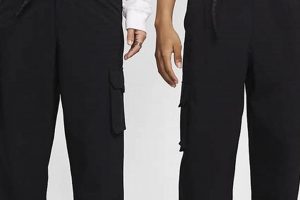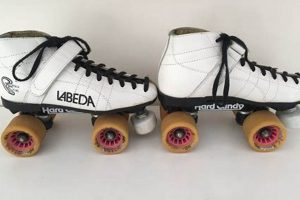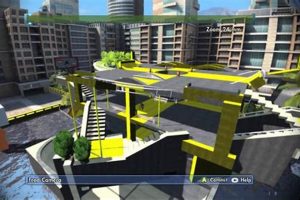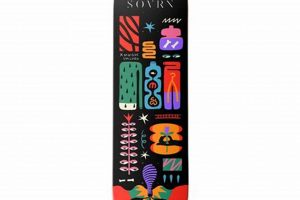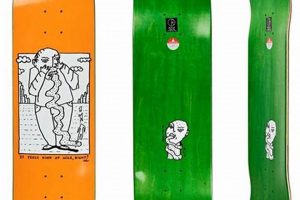Equipment designed to allow very young children to glide on a surface, these items typically prioritize stability and safety over high speeds or complex maneuvers. Examples often incorporate adjustable sizing and secure fastening systems, intended to accommodate rapid growth and limited motor skills.
These specialized products offer several advantages for early childhood development. They can foster balance, coordination, and gross motor skills, while also providing a fun and engaging form of physical activity. Historically, variations of wheeled footwear have existed for centuries, but adaptations specifically catering to the needs and capabilities of young children represent a more recent innovation focused on safety and ease of use.
The following sections will delve into the key considerations when selecting these items, encompassing safety features, sizing guidelines, and maintenance practices to ensure a positive and secure experience.
Essential Guidance for Selecting Wheeled Footwear for Young Children
The following recommendations aim to provide clarity and direction when choosing appropriate wheeled footwear for toddler-aged individuals, prioritizing safety and developmental suitability.
Tip 1: Prioritize Adjustable Sizing: Young children grow rapidly. Selecting equipment with adjustable sizing mechanisms ensures a proper fit over an extended period, maximizing comfort and safety.
Tip 2: Emphasize Secure Fastening Systems: Ensure straps, buckles, or other closure methods are robust and reliable, preventing accidental detachment during use. Regularly inspect these components for wear and tear.
Tip 3: Consider Wheel Configuration for Stability: Configurations with wider wheel bases or multiple wheels at the rear often offer enhanced stability, particularly beneficial for beginners with developing balance.
Tip 4: Opt for Protective Gear: Always utilize appropriate protective equipment, including helmets, knee pads, and elbow pads, to mitigate the risk of injury during falls or collisions.
Tip 5: Supervise Usage Closely: Constant adult supervision is crucial, especially when children are first learning to use this equipment. Ensure they are using it in a safe environment, free from obstacles and hazards.
Tip 6: Introduce Usage Gradually: Begin with short sessions and gradually increase the duration as the child gains confidence and proficiency. Avoid pushing them beyond their comfort level.
Tip 7: Inspect Regularly: Before each use, meticulously inspect the equipment for any signs of damage, loose parts, or wear. Address any issues promptly to maintain optimal safety.
Adherence to these guidelines will contribute to a safer and more positive experience for young children engaging in wheeled activities, promoting physical development and enjoyment while minimizing potential risks.
The next section will explore the long-term maintenance and storage of these items to ensure their continued safety and functionality.
1. Adjustable sizing
Adjustable sizing is a critical feature in wheeled footwear designed for toddler use. The rapid physical development characteristic of this age group necessitates equipment that can accommodate changes in foot size over relatively short periods. The absence of adjustable sizing would require frequent replacement of equipment, incurring additional cost and potentially interrupting the child’s learning process. A properly sized skate, achievable through adjustability, ensures optimal comfort and stability, minimizing the risk of chafing, slippage, and subsequent falls. For example, a skate that is too large can impede a toddler’s ability to maintain balance, while one that is too small restricts movement and can cause discomfort or injury.
The incorporation of adjustable mechanisms, such as sliding toe caps or ratcheting buckle systems, allows for precise calibration of the skate’s internal dimensions. This adaptability enables the equipment to “grow” with the child, providing a longer lifespan and a more consistent fit. Manufacturers often specify a range of adjustability, typically spanning several shoe sizes. Furthermore, adjustable sizing contributes to safety by ensuring that the foot is securely and correctly positioned within the skate, maximizing the effectiveness of other safety features, such as ankle supports and fastening systems. The functionality of the skates depends on the sizing.
In summary, adjustable sizing represents a fundamental design consideration for wheeled footwear intended for toddlers. It directly impacts comfort, stability, safety, and cost-effectiveness. Choosing equipment with a sufficient range of adjustability is therefore a key factor in providing a positive and developmentally beneficial experience. Failure to prioritize adjustable sizing could compromise both the child’s safety and their enthusiasm for the activity, and can result in injury.
2. Secure Fastening
Secure fastening mechanisms constitute an indispensable element in the design and functionality of wheeled footwear intended for toddler use. The integrity of these systems directly impacts safety, stability, and the overall user experience. Inadequate or unreliable fastening can lead to instability, potential injury, and a diminished capacity for the child to effectively control their movements.
- Ankle Support and Stability
A secure fastening system plays a critical role in providing adequate ankle support. This is especially crucial for toddlers, as their ankle strength and stability are still developing. A well-designed fastening system, encompassing straps, buckles, or laces, ensures that the ankle is firmly held in place, reducing the likelihood of sprains or other ankle-related injuries. Without adequate ankle support, the user is at significantly increased risk of losing balance and sustaining a fall.
- Preventing Premature Detachment
The primary function of a secure fastening mechanism is to prevent the skate from detaching from the foot during use. This is particularly important in high-activity scenarios where sudden movements or impacts can place significant stress on the fastening system. A robust and reliable closure, whether it be a buckle, strap, or lace system, minimizes the risk of the skate inadvertently coming loose, which can lead to loss of control and potential accidents. For instance, a loose skate could cause a toddler to trip and fall, resulting in serious injuries.
- Distribution of Pressure and Comfort
A well-designed fastening system not only secures the skate to the foot but also distributes pressure evenly across the foot’s surface. This is crucial for maintaining comfort, especially during extended use. Fastening mechanisms that concentrate pressure on specific points can lead to discomfort, chafing, or even blisters. Effective systems employ padded straps or ergonomically designed closures to distribute pressure, ensuring a comfortable and secure fit that minimizes the risk of irritation.
- Durability and Resistance to Wear
The fastening system should be constructed from durable materials that can withstand the rigors of repeated use and exposure to environmental elements. Toddlers are often less cautious with their equipment, and the fastening mechanism is subjected to frequent opening and closing. A robust and durable system resists wear and tear, maintaining its integrity and functionality over time. Regularly inspecting the fastening system for signs of damage, such as frayed straps or cracked buckles, is essential to ensure continued safety and performance.
In conclusion, secure fastening mechanisms represent a foundational component of safe and effective wheeled footwear for toddlers. These systems directly contribute to ankle support, prevent detachment during use, distribute pressure for enhanced comfort, and demonstrate resistance to wear and tear. Prioritizing these facets within a fastening design results in equipment that promotes both safety and a positive user experience, thereby fostering confidence and enjoyment in physical activity.
3. Wheel stability
Wheel stability represents a critical design parameter in wheeled footwear engineered for toddler use. Its influence extends directly to safety, ease of use, and the development of essential motor skills. A lack of adequate stability can result in frequent falls, discouraging the user and potentially leading to injury.
- Wheelbase Width and its Impact
The width of the wheelbase, defined as the distance between the wheels on the same axle, directly affects stability. A wider wheelbase provides a lower center of gravity and a more stable platform. This configuration is particularly beneficial for novice users who are still developing their balance. In contrast, a narrow wheelbase necessitates greater balance control and can be more challenging for toddlers to manage, increasing the likelihood of instability and falls.
- Wheel Configuration and Support
Variations in wheel configuration influence the overall stability of the equipment. Traditional inline designs, while common in adult skates, can be less suitable for toddlers due to their inherent instability. Alternatives, such as quad designs (two wheels at the front and two at the rear) or triskate designs (two wheels at the rear and one at the front), offer a broader base of support and enhanced stability for beginners. The arrangement and number of wheels contribute significantly to the ease with which a child can maintain balance and control.
- Wheel Material and Surface Friction
The material composition of the wheels impacts their interaction with the skating surface, subsequently influencing stability. Softer wheel materials, such as polyurethane with lower durometer ratings, tend to offer greater grip and reduced slippage, particularly on smooth surfaces. This increased friction enhances stability and control, reducing the likelihood of unexpected slides or loss of traction. Conversely, harder wheel materials provide less grip and are more prone to slipping, requiring greater balance control and potentially increasing the risk of falls.
- Bearing Quality and Rolling Resistance
Bearing quality affects the smoothness and consistency of wheel rotation, which indirectly influences stability. High-quality bearings minimize rolling resistance, allowing the wheels to turn smoothly and predictably. Excessive rolling resistance can create jerky or uneven movement, making it more difficult for the user to maintain balance and control. Smooth, consistent wheel rotation promotes stability by reducing sudden changes in speed or direction.
The integration of these wheel stability considerations into the design of wheeled footwear for toddlers is paramount. A focus on wider wheelbases, supportive wheel configurations, appropriate wheel materials, and high-quality bearings collectively enhances stability, promotes confidence, and contributes to a safer and more enjoyable experience. Neglecting these factors can compromise safety and impede the child’s ability to develop fundamental motor skills.
4. Protective gear
The utilization of protective gear is inextricably linked to the safe and effective use of wheeled footwear designed for toddlers. Given the inherent risks associated with learning to balance and maneuver on wheels, the implementation of appropriate protective measures becomes a non-negotiable element of the overall experience. Protective equipment serves to mitigate the potential for injury resulting from falls, collisions, and other unforeseen incidents that are common during the early stages of skill acquisition. Examples include helmets, knee pads, elbow pads, and wrist guards, each designed to shield vulnerable body parts from impact forces. The absence of such equipment significantly elevates the likelihood of serious injury, ranging from abrasions and contusions to fractures and head trauma.
The selection and proper fitting of protective gear are equally critical. A helmet must conform to relevant safety standards and fit snugly to the head, providing comprehensive coverage and impact absorption. Knee pads and elbow pads should be securely fastened and positioned to protect the corresponding joints without restricting movement. Wrist guards offer support and protection against hyperextension injuries, which are common during falls onto outstretched hands. Real-world examples underscore the significance of protective gear: a toddler falling backward while learning to skate may sustain a serious head injury without a helmet, while knee and elbow pads can prevent painful scrapes and bruises. The appropriate use of these measures demonstrably reduces the severity and frequency of injuries.
In summary, the integration of protective gear into the practice of using wheeled footwear by toddlers is not merely an optional precaution, but rather a fundamental requirement for ensuring their safety and well-being. Failure to prioritize protective measures exposes young children to unnecessary risks and undermines the potential benefits of this form of physical activity. The understanding and conscientious application of these principles are essential for parents, caregivers, and instructors involved in introducing wheeled activities to toddlers.
5. Adult supervision
Adult supervision is a non-negotiable element when toddlers engage with wheeled footwear. The age-related limitations in judgment, coordination, and risk assessment necessitate continuous oversight to ensure a safe and positive experience.
- Hazard Identification and Mitigation
Adults possess the cognitive capacity to identify potential hazards within the environment, such as uneven surfaces, obstacles, or traffic, that a toddler may not perceive. Active supervision enables the preemptive mitigation of these risks, preventing potential accidents or injuries. An adult can guide the toddler away from a cracked sidewalk or clear debris from the skating area, actions beyond the cognitive capabilities of the child.
- Enforcement of Safety Protocols
Adult supervision facilitates the consistent enforcement of safety protocols, including the mandatory use of protective gear (helmets, knee pads, elbow pads) and adherence to designated skating areas. Toddlers may resist wearing protective equipment or stray into unsafe zones without adult intervention. Constant monitoring ensures compliance with safety guidelines, minimizing the likelihood of injuries. For example, an adult can ensure the helmet is properly fastened and prevent the child from skating on a busy street.
- Assessment of Skill Level and Fatigue
Adults can accurately assess a toddler’s skill level and fatigue, adjusting the duration and intensity of the activity accordingly. Toddlers may overestimate their abilities or be reluctant to stop even when fatigued, increasing the risk of falls or overexertion. A responsible adult can recognize signs of fatigue or frustration and recommend a break or a less challenging activity. Observing the child’s posture and coordination allows an adult to gauge their physical and mental state, preventing potential accidents.
- Immediate Response to Incidents
In the event of a fall or other incident, adult supervision ensures an immediate response, providing first aid, comfort, and appropriate medical attention if required. Toddlers may be unable to accurately communicate their injuries or seek help independently. The prompt intervention of an adult can minimize the severity of injuries and provide reassurance to the child. Knowing an adult is present offers the child a sense of security, fostering a more positive and confident approach to learning.
The multifaceted nature of adult supervision directly impacts the safety and overall benefit derived from wheeled activities for toddlers. Its consistent implementation is not merely a recommendation, but a critical requirement for fostering a secure and developmentally enriching environment.
6. Gradual Introduction
The process of gradually introducing wheeled footwear to toddlers represents a critical pedagogical approach, directly influencing both safety and the development of proficiency. A measured and incremental introduction minimizes the potential for overwhelming the child, fostering a positive association with the activity and maximizing the likelihood of sustained engagement.
- Minimizing Fear and Anxiety
Initial exposure to wheeled footwear can elicit fear or anxiety in some toddlers. A gradual approach allows the child to acclimate to the equipment and the sensation of movement at their own pace. Introducing the skates in a familiar and supportive environment, such as indoors on a carpeted surface, can help reduce anxiety. Forcing a child to use the skates prematurely may create a negative association, hindering future attempts.
- Developing Fundamental Motor Skills
Mastering wheeled footwear requires the development of fundamental motor skills, including balance, coordination, and spatial awareness. A gradual introduction allows the child to progressively develop these skills, starting with simple movements and gradually progressing to more complex maneuvers. For example, a child might begin by simply standing still in the skates, then progress to walking short distances, before attempting to glide. This incremental approach ensures a solid foundation for future skill development.
- Promoting Muscle Strength and Endurance
Using wheeled footwear engages various muscle groups, requiring strength and endurance. A gradual introduction allows the child to progressively build these physical attributes, preventing muscle fatigue and reducing the risk of injury. Starting with short sessions and gradually increasing the duration as the child gains strength is a key element of this approach. Overexertion can lead to muscle strain or fatigue, potentially discouraging the child from continuing the activity.
- Enhancing Proprioceptive Awareness
Proprioception, the sense of body position and movement, is crucial for maintaining balance and coordination on wheeled footwear. A gradual introduction provides the child with ample opportunity to develop this sense, allowing them to become more aware of their body’s position in space and to make necessary adjustments to maintain balance. Repeated exposure to the sensation of gliding on wheels enhances proprioceptive awareness, improving overall motor control.
These facets underscore the importance of a measured approach to introducing wheeled footwear to toddlers. By prioritizing gradual progression, parents and caregivers can foster a positive learning experience, minimize the risk of injury, and maximize the developmental benefits associated with this form of physical activity. The long-term success and enjoyment of the activity are directly linked to this methodical process.
Frequently Asked Questions
This section addresses common inquiries and misconceptions regarding wheeled footwear designed for toddlers, providing clear and concise information to promote safe and informed decision-making.
Question 1: At what age is a child ready to begin using wheeled footwear?
There is no universally applicable age; however, most children demonstrate sufficient balance and coordination around the age of two or three. Assessment of individual motor skills and developmental readiness is paramount. Consultation with a pediatrician or physical therapist may provide further guidance.
Question 2: What are the essential safety features to consider when selecting wheeled footwear?
Adjustable sizing, secure fastening systems, and stable wheel configurations are crucial. Protective gear, including helmets, knee pads, and elbow pads, is mandatory. Adherence to recognized safety standards and certifications (e.g., ASTM) is also recommended.
Question 3: How should wheeled footwear be properly fitted to a toddler?
The foot should fit snugly within the boot or frame, allowing for minimal movement. Toes should have adequate room to wiggle, and the heel should be firmly secured to prevent slippage. Adjustable straps or buckles should be tightened to provide a secure and comfortable fit, without restricting circulation.
Question 4: What type of surface is most suitable for using wheeled footwear?
Smooth, flat, and paved surfaces, such as sidewalks or paved bike paths, are generally recommended. Avoid surfaces with cracks, gravel, or other obstacles that could cause a loss of balance. Indoor use on carpeted surfaces may be appropriate for initial familiarization.
Question 5: How long should a toddler’s initial sessions with wheeled footwear be?
Initial sessions should be brief, typically lasting 15-30 minutes, to prevent fatigue and frustration. Gradually increase the duration as the child gains confidence and proficiency. Monitor the child for signs of fatigue or discomfort and adjust the activity accordingly.
Question 6: What steps should be taken to maintain wheeled footwear in good condition?
Regularly inspect the equipment for signs of wear or damage. Clean the wheels and bearings periodically to remove dirt and debris. Store the footwear in a dry, protected environment to prevent deterioration of materials. Replace worn or damaged components promptly.
Prioritizing safety, proper fit, and gradual introduction are essential for fostering a positive and developmentally beneficial experience for young children engaging with wheeled footwear.
The subsequent section will address maintenance and storage guidelines to ensure the longevity and safety of wheeled footwear.
Concluding Remarks on Wheeled Footwear for Toddlers
This exploration has highlighted critical facets related to “skates for toddlers.” Adjustable sizing, secure fastening, wheel stability, and mandatory protective gear contribute directly to safety. Adult supervision and a gradual introduction are indispensable pedagogical elements. These factors collectively ensure a secure and developmentally appropriate experience.
Responsible selection and implementation of these considerations are paramount. Parents and caregivers must prioritize safety above all else. A conscientious approach will foster not only physical development but also confidence and a positive association with physical activity. The potential benefits of “skates for toddlers” are realized only through informed and diligent practice.


